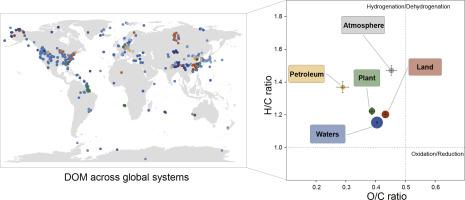Global patterns and drivers of dissolved organic matter across Earth systems: Insights from H/C and O/C ratios
IF 6.3
3区 综合性期刊
Q1 Multidisciplinary
引用次数: 0
Abstract
Dissolved organic matter (DOM) is ubiquitous and contains a complex pool of thousands of distinct molecules, and their chemical characteristics help us inform the fate of global carbon. However, a more holistic perspective of the molecular characteristics of DOM and underlying mechanisms across Earth systems and climates remains under study. Here, we present a comprehensive analysis of the molecular characteristics of DOM using two abundance-weighted average indices, i.e., H/C and O/C ratios, by compiling 2,995 samples from 317 studies covering waters, land, plant, petroleum, and atmosphere systems and climatic regions from the tropics to tundra. H/C ratios are lower on average in waters (H/C = 1.15 ± 0.005) and land (H/C = 1.20 ± 0.010) than in the other systems, while their O/C ratios rank between plant and atmosphere systems. In the waters and land systems, the H/C ratios of DOM vary from the highest to the lowest in the habitats of the land-to-ocean continuum generally as snow > glacier > marine ≥ freshwater/soil > groundwater. The H/C ratios show predictably U-shaped patterns along latitudinal gradients, indicating the lowest abundance of more hydrogen-saturated molecules at mid-latitudes of approximately 40°-50° in river water, lake water, and forest soil. The two ratios are primarily controlled by environmental factors such as pH, dissolved oxygen, and carbon and nitrogen contents. We further unveil additional and considerable links between the ratios and the extremes of climatic factors such as precipitation of warmest quarter and maximum temperature of warmest month. Our synthesis provides molecular-level perspectives to characterize the global distribution and underlying drivers of DOM, which is complementary for our understanding of global carbon cycle processes under future global change.

地球系统中溶解有机物的全球模式和驱动因素:从H/C和O/C比率看问题
溶解有机物(DOM)无处不在,包含了数千种不同分子的复杂池,它们的化学特征帮助我们了解全球碳的命运。然而,关于DOM的分子特征和跨地球系统和气候的潜在机制的更全面的观点仍在研究中。本文利用H/C和O/C两种丰度加权平均指标,对DOM的分子特征进行了综合分析,收集了从热带到苔原的317个研究项目的2995个样本,涵盖了水、土地、植物、石油和大气系统以及气候区域。水体(H/C = 1.15±0.005)和陆地(H/C = 1.20±0.010)的H/C比值均低于其他系统,O/C比值介于植物系统和大气系统之间。在水域和陆地系统中,DOM的H/C比值在陆-海连续体生境中由高到低,一般表现为雪&冰川&海洋≥淡水/土壤&地下水。H/C比值沿纬度梯度呈可预测的u型模式,表明在中纬度约40°-50°的河流、湖泊和森林土壤中,氢饱和分子丰度最低。这两个比值主要受pH、溶解氧、碳氮含量等环境因素的控制。我们进一步揭示了这些比率与极端气候因素(如最温暖季度的降水和最温暖月份的最高温度)之间的额外和相当大的联系。我们的合成提供了分子水平的视角来表征DOM的全球分布和潜在驱动因素,这对我们理解未来全球变化下的全球碳循环过程是互补的。
本文章由计算机程序翻译,如有差异,请以英文原文为准。
求助全文
约1分钟内获得全文
求助全文
来源期刊

Fundamental Research
Multidisciplinary-Multidisciplinary
CiteScore
4.00
自引率
1.60%
发文量
294
审稿时长
79 days
期刊介绍:
 求助内容:
求助内容: 应助结果提醒方式:
应助结果提醒方式:


